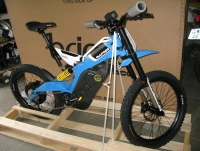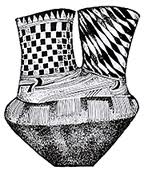http://www.allempires.com/forum/forum_posts.asp?TID=27064
Gotvand is a village near the city of Dezful in the north Khuzestan province, this is its exact location: traveljournals.net/explore/iran/map/m4303006/gotvand.html, there a large percent of light-haired people (Mam-ruti, according to Mesopotamian texts) in this region, for example one of the most famous Iranian who was born in this village is Mohammad-Ali Ramin, Presidential Advisor who has blonde hair. A Gotvandi woman in traditional Khuzestani dress, A Dezfuli boy in traditional costume.





And this the location of ancient Gutium (land of Gutians). As you see this is almost the same location of Gotvand and Dezful in the north of Khuzestan province of Iran, we know the only people who were called Mam-ruti (light-haired) in the Mesopotamian texts were Gutians and we see in some Babylonian inscriptions that they are called blonde-headed people, like this one:

Gotvand means land of Goti in Dezfuli language, of course Dezfuli is also an Iranian language but the pronunciation of the words differ from Iranian languages, they themselves believe that this is similar to English, something about Dezfuli language in Persian: http://www.dezonline.ir/viewtopic.php?f=73&t=582, for example Click Here, you can hear Dezfuli words and their Persian translation.
There are some linguistic books about Dezfuli/Gotvandi language in Persian, most of them talk about a non-Iranian origin of this language, for example there is a book titled “Dezfuli – English common origin words“, you can read here that it was among top linguistic books of 2008 in Iran: ifriran.org/Bibliotheque/NouvellesAcquisitionsIraniennes.pdf
NEJAT’ALI, Nosratollâh, Vâzhegân-e moshâbeh-e Dezfuli – Engelisi.- Qom : Nejâbat, 2007/1386.- 165 p. More info about this book: adinebook.com/gp/product/9648527971
It talks about numerous common origin words in these two languages, one of these words is Dezfuli Vand and English Land. etymonline.com land (n.) ![]() O.E. land, lond, “ground, soil,” also “definite portion of the earth’s surface, home region of a person or a people, territory marked by political boundaries,” from P.Gmc. *landom (cf. O.N., O.Fris. Du., Ger., Goth. land), from PIE *lendh- “land, heath” (cf. O.Ir. land, Middle Welsh llan “an open space,” Welsh llan “enclosure, church,” Breton lann “heath,” source of Fr. lande; O.C.S. ledina “waste land, heath,” Czech lada “fallow land”). Etymological evidence and Goth. use indicates the original sense was “a definite portion of the earth’s surface owned by an individual or home of a nation.”
O.E. land, lond, “ground, soil,” also “definite portion of the earth’s surface, home region of a person or a people, territory marked by political boundaries,” from P.Gmc. *landom (cf. O.N., O.Fris. Du., Ger., Goth. land), from PIE *lendh- “land, heath” (cf. O.Ir. land, Middle Welsh llan “an open space,” Welsh llan “enclosure, church,” Breton lann “heath,” source of Fr. lande; O.C.S. ledina “waste land, heath,” Czech lada “fallow land”). Etymological evidence and Goth. use indicates the original sense was “a definite portion of the earth’s surface owned by an individual or home of a nation.”
I think Swastika could be originaly a Gutian symbol because the oldest ones have been found in this region.
One interesting word is “Nal“, this word means “shoe, sandal, sock” in Arabic and especially “horseshoe” in Modern Persian, but its original meaning in Gotvandi is “Needle”, the reason could be that from this word, there was the Middle Persian “Nalbandi” which means “Sandal making”, this Middle Persian word can be found in Old Arabic -> Arabic-English Dictionary and some other languages, like Armenian, you probably know the famous tennis player David Nalbandian. The second part of the word is band “bind”: PIE *bhendh– “to bind.”
-
Sanskrit bandhah “a tying, bandage,” Avestan band- “to bind,” Old Persian band “to bind,” Gothic bandi “that which binds; Middle Irish bainna“bracelet.” Persian “Nalbandi” can be compared with Scandinavian “Nålbinding“: http://en.wikipedia.org/wiki/Nlebinding >> literally “binding with a needle” or “needle-binding”
>> The oldest known samples of single-needle knitting include the color-patterned sandal socks of the Coptic Christians of Egypt.
>> It is still used in Iran to make socks, and in parts of Scandinavia to make hats, gloves and other items that are very warm.
“Nålbinding is currently done in many places around the world although it is definitely beginning to die out in our 21st century. According to my sources it is still practiced in at least the following places: the mountainous regions of Central Asia;24 Persia, i.e. Lurestan and Iran;25 Sweden;26 Norway;27 Denmark (possibly); …” A History of art By Lawrence Gowing: books.google.com/books/luristan..

From a proto-IE word which meant “Horn”, there are the names of some wind musical instruments like Roman Cornu in the Centum languages and PersianSorna in the Satem languages, you can read here about Sorna: http://en.wikipedia.org/wiki/Sorna that this is the main instrument of Luristan, so we see it is also called “Saz-e-Luri” (Luri musical instrument) in Persian too, the interesting thing is that Scandinavians also call it “Lur“.
Something interesting about Goths: http://en.wikipedia.org/wiki/Goths
Etymologically the oldest (300 BC) ethnonym for the Goths, “Guton-“,[3] derives from the same root as that of the Gotlanders (“Gutar“): the Proto-Germanic *Gutaniz. Related, but not the same, is the Scandinavian tribal name Geat, from the Proto-Germanic *Gautoz (plural *Gautaz). Both *Gautoz and *Gutaniz are derived (specifically they are two ablaut grades) from the Proto-Germanic word *geutan, meaning “to pour”.
You probably know some great Parthian kings named Gotarzes (Persian Gudarz), the interesting thing is that this is the name of an ancient region near Borujerd (Middle Persian Vorugard) in Luristan province too, some years ago in this thread: Origins of polish, I said: Kashubi -> Kashian (Kassite) or Kashvad (One of descendants of Kaveh, founder of Gudarzian dynasty)
Gutarzian or Gudarzian was in fact a mythological dynasty of Greater Iranian tradition and folklore and you can read here about Kassites:http://en.wikipedia.org/wiki/Kassites “The original homeland of the Kassites is obscure, but appears to have been located in the Zagros Mountains in Lorestan in Iran.”
Other than archaeologists, we see anthropologists also say that there is a connection betweem people of Lorestan, the Caucasus (North Armenia) and Scandinavia and consider them as belonging to a common Nordic-Iranian race, you can read here: Nordic race in north Armenia -> “People of Lori province of north Armenia are mainly Nordic with slight local Armenoid admixture.”, this is really interesting that this part of the Caucasus has been also called “Lori” from the ancient times, so for “Lori” there are: http://en.wikipedia.org/wiki/Lori
Lori may refer to: Lori Province, Armenia * Luri language, spoken by the Lur people Lorestān, Iran * Kingdom of Lori-Joraget, an Armenian kingdom from c. 980 to 1240
About Nordic-Iranian, Phallanx has posted a good article which mentions it in this thread: http://www.allempires.net/forum_posts.asp?TID=3900 (Who are the modern day “Greeks”?)
Nordic-Iranians (Type D)
Nordic-Iranians (Type D: Plate XL, m-q) have long and high heads with peculiarly deep occiputs, smooth ovoid-ellipsoid contour, sharply-cut muscle impressions, strong browridges, and tilted and capacious foreheads. Marked facial height and narrowness of cheeks compared to wide forehead and jowls makes a rectangular, horse-faced impression. Large but slightly retreating cheekbones enclose drooping orbits, and big, salient, and aquiline noses, long-arched palates, muscular jaws wide at the angles, and cleft chins lacking prominence all add to the same effect. Nordic-Iranians were tall and muscular, strong-necked, and probably included tawny-haired blue- or green-eyed blonds as well as brunets. Approximate identity, and noteworthy resemblances to North Iranian Bronze Age Proto-Nordics, to Anglo-Saxons, and to medieval Irish Monks show the divided eastern and northern relations of this Greek type. And although Type D has low variability, it includes four slightly different tendencies: a cylindrical-skulled, slab-faced Iron-Age Nordic one (D1: Chalcidian and E. Thracian, in Plate XL, n and o), a high-skulled, ellipsoid, “Corded” tendency (D2: Chalcidian in Plate XL, p slightly “dinaricised”), a long byrsoid, deep-skulled, huge-nosed, convex-profiled Iranian trend (D4: Athenian of Arcadian parentage, in Plate XL, m), and a small-faced Iranian-Mediterranean divergence approaching Coon’s Cappadocian and Danubian types (D3: Athenian in Plate XL, q).
The possible relation between Gutians (Goths) and Hittites, an ancient people who lived in the eastern Turkey and spoke a certain Indo-European language (of Centum branch), is also interesting, This book mostly talks about these things (Guti, Kudti, Kurdi, …) this is a page of it:









Hi Alex’s
I’m Gotvand city dwellers.
There were errors in your article, which you have the desire to do can help you correct them.
Good luck
It is not my article, I did not write there. I just selected some information that I found. If there are things that you think you know better, please ‘correct’, please bring here your information.
Pingback: God created man in God's image? - Page 17 - Christian Forums